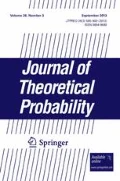Abstract
Let {S n} n≥0 be a random walk on the line. We give criteria for the existence of a nonrandom sequence n i → ∞ for which \(S_{n_i } \xrightarrow{P}\infty \) respectively \(S_{n_i } /n_i \xrightarrow{P}\infty \) We thereby obtain conditions for ∞ to be a strong limit point of {S n} or {S n /n}. The first of these properties is shown to be equivalent to \(S_{T(a_i )} \xrightarrow{P}\infty \) for some sequence a i→ ∞, where T(a) is the exit time from the interval [−a,a]. We also obtain a general equivalence between \(S_{n_i } /f(n_i )\xrightarrow{P}\infty \) and \(S_{T(a_i )} /f(T(a_i ))\xrightarrow{P}\infty \) for an increasing function fand suitable sequences n i and a i. These sorts of properties are of interest in sequential analysis. Known conditions for \(S_n \xrightarrow{P}\infty \) and \(S_n /n\xrightarrow{P}\infty \) (divergence through the whole sequence n) are also simplified.
Similar content being viewed by others
REFERENCES
Erickson, K. B. (1973). On the strong law of large numbers when the mean is undefined, Trans. Amer. Math. Soc. 185, 371–381.
Erickson, K. B., and Kesten, H. (1974). Strong and weak limit points of a normalized random walk, Ann. Prob. 2, 553–579.
Esseen, C. G. (1968). On the concentration function of a sum of independent random variables, Z. Wahrsch. verw. Geb. 9, 290–308.
Griffin, P. S. (1995). A note on random sums with nonrandom centering, Preprint.
Griffin, P. S., and McConnell, T. R. (1992). On the position of a random walk at the time of first exit from a sphere, Ann. Prob. 20, 825–844.
Griffin, P. S., and McConnell, T. R. (1994). Gambler's ruin and the first exit position of random walk from large spheres, Ann. Prob. 22, 1429–1472.
Kesten, H., and Lawler, G. F. (1992). A necessary condition for making money from fair games, Ann. Prob. 20, 855–882.
Kesten, H., and Maller, R. A. (1992). Ratios of trimmed sums and order statistics, Ann. Prob. 20, 1805–1842.
Kesten, H., and Maller, R. A. (1994). Infinite limits and infinite points of random walks and trimmed sums, Ann. Prob. 22, 1473–1513.
Kesten, H., and Maller, R. A. (1996). Two renewal theorems for general random walks tending to infinity, Prob. Th. Rel. Fields 106, 1–38.
Pruitt, W. E. (1981). The growth of random walks and Lévy processes, Ann. Prob. 9, 948–956.
Rights and permissions
About this article
Cite this article
Kesten, H., Maller, R.A. Divergence of a Random Walk Through Deterministic and Random Subsequences. Journal of Theoretical Probability 10, 395–427 (1997). https://doi.org/10.1023/A:1022664500932
Issue Date:
DOI: https://doi.org/10.1023/A:1022664500932




